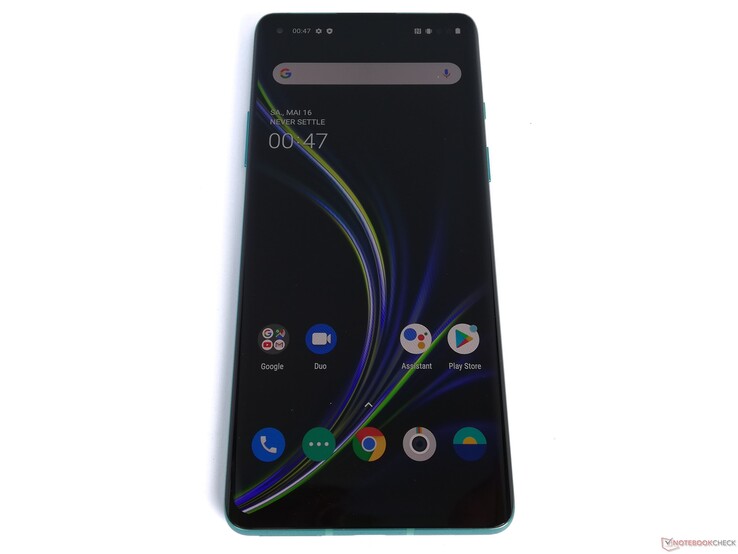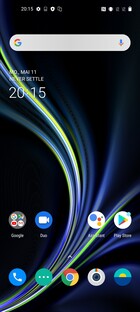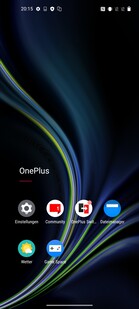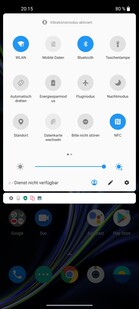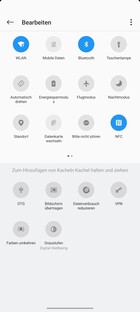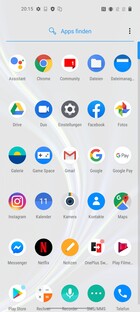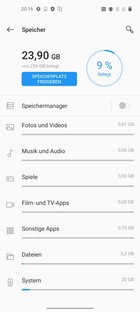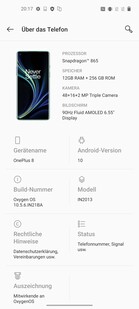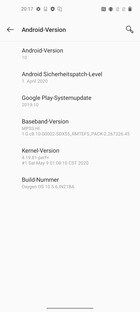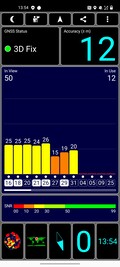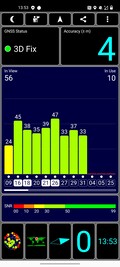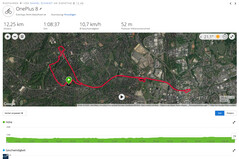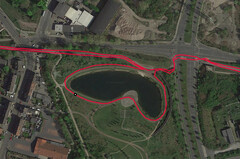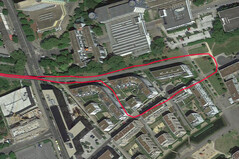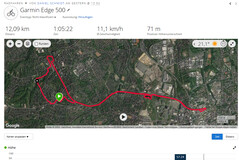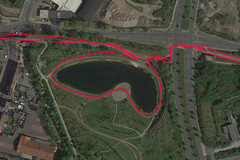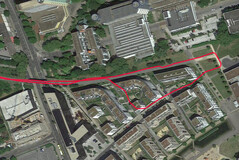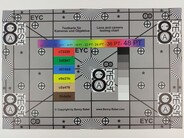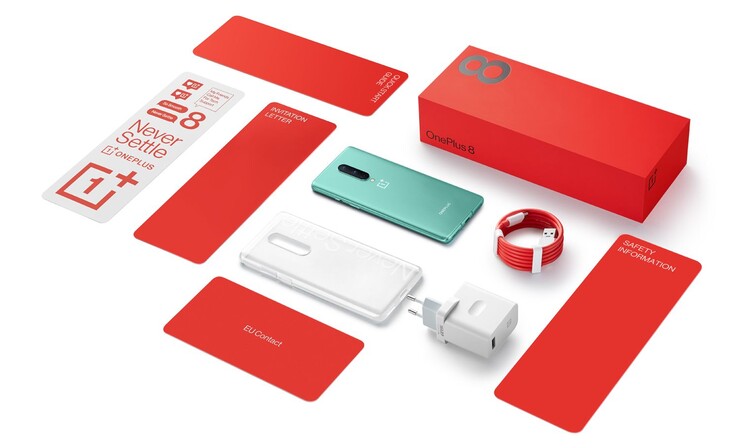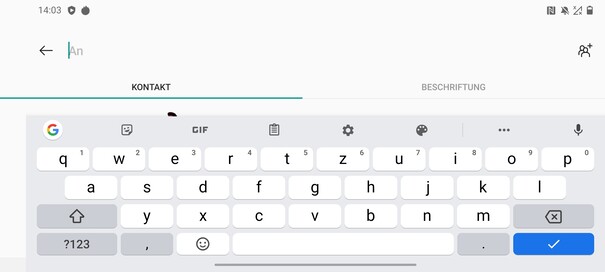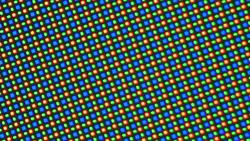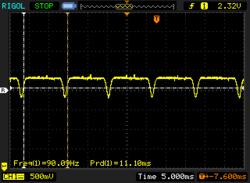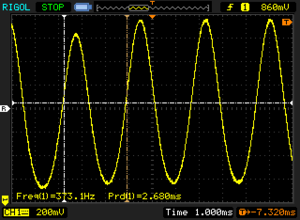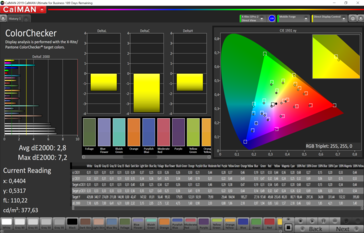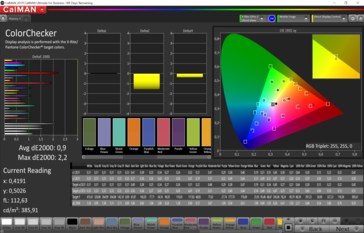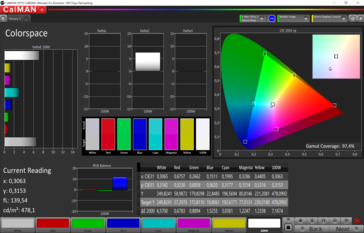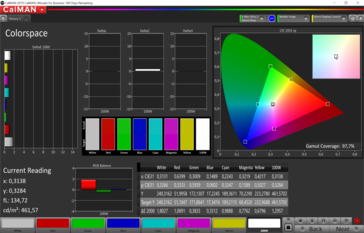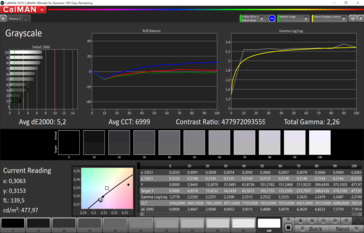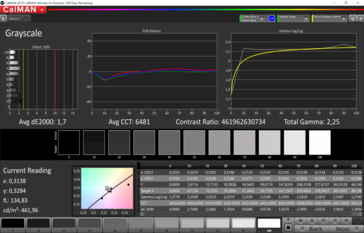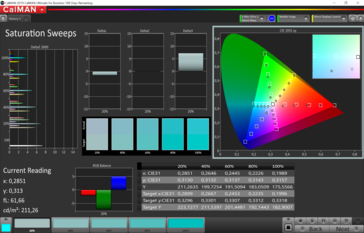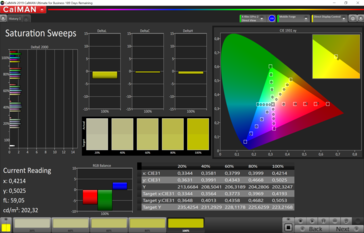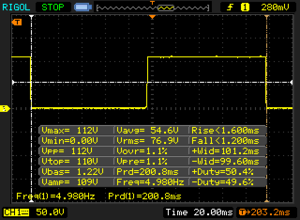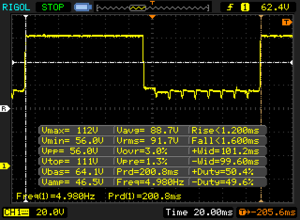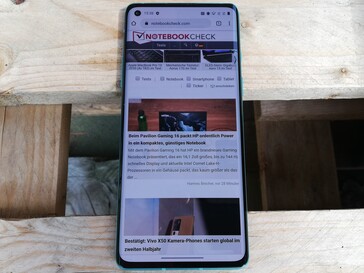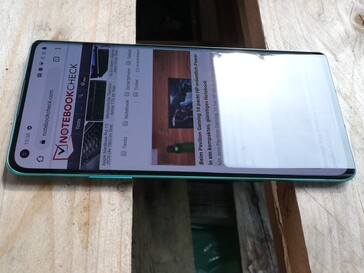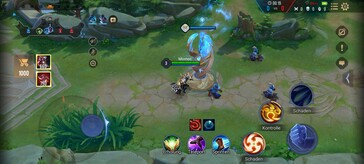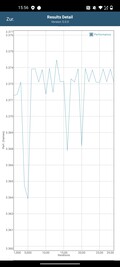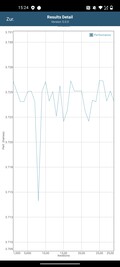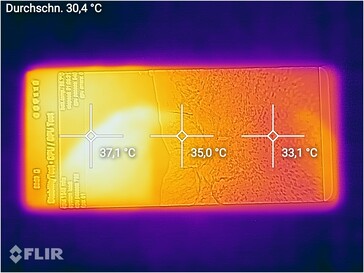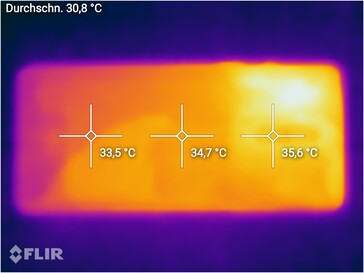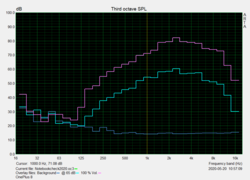OnePlus 8 in Review: Great smartphone even in the non-pro version

Our review of the OnePlus 8 Pro has given us the impression that the manufacturer has evolved. However, the price of its flagship has also increased and is now nearing the $1000 mark. The technology within the OnePlus 8 is similar, while the price of $800 for the top configuration is slightly cheaper. Since the SoC and the memory configuration are identical, prospective buyers may prefer the non-Pro version for its superior price-performance ratio.
In our review, we will compare the OnePlus 8 with the competitors listed below. Additional smartphones from our database can also be added to the comparison beneath every section.
Competing Devices
Rating | Date | Model | Weight | Drive | Size | Resolution | Best Price |
|---|---|---|---|---|---|---|---|
| 88.4 % | 06/2020 | OnePlus 8 SD 865, Adreno 650 | 180 g | 256 GB UFS 3.0 Flash | 6.55" | 2400x1080 | |
| 87.4 % | 04/2020 | Huawei P40 Kirin 990 5G, Mali-G76 MP16 | 175 g | 128 GB UFS 3.0 Flash | 6.10" | 2340x1080 | |
| 87.7 % | 03/2020 | Samsung Galaxy S20 Exynos 990, Mali-G77 MP11 | 163 g | 128 GB UFS 3.0 Flash | 6.20" | 3200x1440 | |
| 87.8 % | 05/2020 | Xiaomi Mi 10 SD 865, Adreno 650 | 208 g | 128 GB UFS 3.0 Flash | 6.67" | 2340x1080 | |
| 85.8 % | 04/2020 | Google Pixel 4 XL SD 855, Adreno 640 | 193 g | 64 GB UFS 2.1 Flash | 6.30" | 3040x1440 |
Case - OnePlus 8 without IP Certification
The OnePlus 8 comes with an extremely high-quality case with a metal frame and, in the case of our "glacial green" test device, with a matte back. The other options are "interstellar glow" and "onyx black", the latter of which has a shiny back.
The front is defined by the waterfall display with rounded-off edges, which consists of Corning Gorilla Glass to protect it from breaking. Unlike the OnePlus 8 Pro, the OnePlus 8 does not have an IP certification. Despite its display size of 6.5 inches diagonally, the OnePlus 8 is fairly compact. At 180 g, it is also slightly lighter than other devices with similar sizes such as the smaller Google Pixel 4 XL.
Features - OnePlus 8 without microSD Card Reader
Our OnePlus 8 test model uses a Qualcomm Snapdragon 865 with an Adreno 650 graphics unit, 12 GB of RAM and 256 GB of UFS 3.0 storage. A variant with 8 GB of RAM and 128 GB of internal storage can be purchased for about $100 less. Since the manufacturer has decided against integrating a microSD card slot, users with higher storage requirements would be wise to strongly consider the 256-GB version. Both models support two nano SIM cards with VoLTE and Wi-Fi calling.
A USB Type-C port with support for USB 3.1 Gen. 1 is available for wired data transfers. Additionally, Camera2 API level 3 and DRM Widevine L1 are on board. However, the manufacturer has decided against a notification LED and instead there is a mechanical mute button. The latter allows for switching between ringtone, mute and vibration mode.
Software - OxygenOS by OnePlus
Oxygen OS version 10.5.6, which is based on Android 10 and includes security patches from April 1, 2020, runs on the OnePlus 8. The Android system is very similar to stock Android and there are only a few additional apps from the manufacturer preinstalled. This includes the OnePlus community app for example, which can be used to directly communicate with other OnePlus users as well as to view announcements from the manufacturer.
The slightly reorganized settings menu is easy to navigate, since it is very neatly arranged. It is worth it to adjust the battery optimization settings for frequently used applications. While the system behavior is not particularly aggressive against background apps, the system kills apps that it deems inactive after two to three hours.
Communication and GPS - Fast WLAN and 5G
The OnePlus 8 is able to connect to GSM, 3G and LTE cellular networks. The LTE module is compatible with cat. 18 downloads and cat. 13 uploads for transfer speeds of 1200 Mb/s and 150 Mb/s, respectively. Furthermore, the 5G support includes bands n1 and n78, which are currently being used to extend the 5G coverage in a few European countries.
As for short-range communications, users of the OnePlus 8 have access to NFC, Bluetooth 5.1 and Wi-Fi 6. In conjunction with our reference router Netgear Nighthawk AX12, our test device achieves good Wi-Fi transfer speeds. With an average of 894 Mb/s and 937 Mb/s for receiving and sending data, respectively, the 5G smartphone achieves above-average results in our comparison.
| Networking | |
| iperf3 transmit AX12 | |
| Huawei P40 | |
| OnePlus 8 | |
| Samsung Galaxy S20 | |
| Xiaomi Mi 10 | |
| Google Pixel 4 XL | |
| iperf3 receive AX12 | |
| Huawei P40 | |
| Xiaomi Mi 10 | |
| OnePlus 8 | |
| Samsung Galaxy S20 | |
| Google Pixel 4 XL | |
| Average of class Smartphone (last 2 years) | |
We use the app GPS Test to determine the accuracy of the GPS module inside the OnePlus 8. GPS, GLONASS, Galileo and BeiDou are available for an outdoor accuracy of within four meters. Indoors, the precision decreases to be within 12 meters.
On our bike ride, the OnePlus 8 achieves a similar accuracy as our reference device Garmin Edge 500. As a result, it is well suited to daily navigation tasks.
Telephony and Call Quality - Clear Voices
The telephony app of the OnePlus 8 gives users direct access to the favorites and a dial pad. Additionally, the call history and contacts are available through two extra tabs. During our test call, the volume level of the smartphone is satisfactory and voices sound distinct. However, both the earpiece and the speakerphone suffer from a small amount of static. Both conversational partners can still be clearly understood and the microphone reliably filters out ambient noise.
Cameras - Good Pictures with Small Deficits in Low-light Situations
The OnePlus 8 is equipped with a triple-camera system that includes a 48-MP main sensor. The latter captures pictures with an f/1.75 aperture, 25 mm focal length and a pixel width of 0.8 µm. Additionally, there is a 16-MP sensor with an f/2.2 aperture and a focal length of 13 mm for ultra-wide-angle shots as well as a 2-MP sensor with an f/2.4 aperture for depth information. The front camera has a resolution of 16 MP and is very well suited to taking portrait shots. Here, fine details are clearly defined and the color balance is good as well. Furthermore, details still remain visible at higher zoom levels. Meanwhile, users can only select a beauty mode with three steps and various color filters in the settings menu of the camera app to influence the resulting picture.
Similarly, the main camera of the OnePlus 8 captures great pictures under good lighting conditions. Different aspects of the image are distinct from one another and the level of detail is excellent. Here, the color balance looks very convincing and a slight grain effect can only be observed when using the bokeh effect at higher zoom levels. In pictures captured by the ultra-wide-angle lens, object outlines are not quite as precise. However, details are still easily discernible. At 5x zoom, the object in focus is still accurately reproduced overall, although even lower zoom levels already introduce slight sharpness issues and a noticeably lower resolution. This causes details to get lost and colors also look paler than in non-enhanced pictures. Under poor lighting conditions, the picture of our test object, which was taken by the main optics, is just barely recognizable. There are black areas near the corners and colors appear to be significantly darker than they should. The low-light picture was captured without night mode, which can significantly enhance the image quality. Aside from the usual color filter options, users can also influence the result via a pro mode. Here, the ISO, color balance, shutter speed, focal length and exposure values can be manually set.
The video quality of the OnePlus 8 is similar to the quality of our test images. During the recordings, an excellent image stabilizer compensates for camera shake and there is a time-lapse mode and a slow-motion mode available. The slow-motion mode supports up to 1080p at 240 FPS or 720p at 480 FPS. The main camera offers the following modes:
- 1080p, 30 FPS, and 60 FPS
- 4K, 30 FPS, and 60 FPS
- 4K, 21:9, 30 FPS, and 60 FPS
Image Comparison
Choose a scene and navigate within the first image. One click changes the position on touchscreens. One click on the zoomed-in image opens the original in a new window. The first image shows the scaled photograph of the test device.
HauptkameraUltraweitZoom (5-fach)LowLightUnder controlled lighting conditions, the ColorChecker passport shows that the camera of the OnePlus 8 heavily overexposes colors in some cases. While they are underexposed at an ambient brightness of 1 lux, they at least remain visible for the most part. The same holds true for the test chart, and although it is also underexposed, only the corners appear black. After readjusting the lighting to its original state, details and structures on the test chart become easy to recognize and colors look well saturated. Only colors in the bottom left exhibit a tiny amount of paleness.
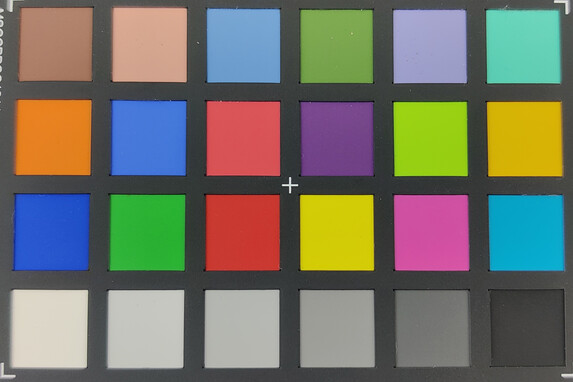
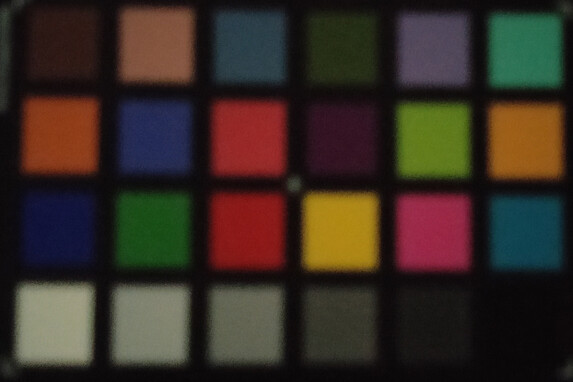
Accessories and Warranty - OnePlus 8 Comes with a Case Included
The package of the OnePlus 8 includes a USB charger with a matching USB Type-C cable, a SIM tool, a silicone case and a few branded stickers. Optional accessories such as various cases, car accessories, headsets, sleeves, and more are available from the manufacturer's online shop.
OnePlus offers its customers a 24-month warranty period.
Input Devices & Handling - Very Smooth Touchscreen
OnePlus has opted to use Google's GBoard as the virtual input method. It offers numerous customization options and allows users to comfortably type longer text passages. The touchscreen responds very well and drag-and-drop operations are easy to perform thanks to the smooth surface of the display. Inputs are confirmed by a slight vibration and, depending on the settings, a subtle sound. Similarly, the gyroscope responds reliably to movements and quickly readjusts the screen contents after changing the orientation of the phone.
In addition to PIN and pattern unlock, the in-screen fingerprint sensor and facial recognition are also available for unlocking the smartphone. During daily use, the sensor within the display recognizes stored prints reliably and two attempts were rarely necessary. Meanwhile, facial recognition has turned out to be a very reliable way to unlock the smartphone, provided the display is active. Depending on the settings, it may thus be necessary to press the power button before facial recognition becomes available.
Display - Smartphone with 90 Hz and PWM
The screen of the OnePlus 8 consists of a 6.55-inch OLED panel with a resolution of 2400x1080 pixels and a refresh rate of 90 Hz. We observed a very good average brightness of 783 cd/m². In the APL50 test, our test device temporarily achieves an even greater result of 939 cd/m². However, the smartphone quickly decreases its brightness as soon as the display becomes too warm, reducing the maximum brightness to only 490 cd/m² in some cases. When the ambient light sensor is disabled, the brightness can be manually set to up to 437 cd/m².
As per usual, the OLED display of the OnePlus uses PWM flickering to control its brightness. With a frequency of between 342.5 Hz and 373.1 Hz, the values are slightly increased when using the 90-Hz mode. At a refresh rate of 60 Hz, the PWM frequency drops to the very common 240-Hz range. That being said, these values are still relatively low and users with sensitive eyes may experience issues after viewing the display of the OnePlus 8 for prolonged periods of time.
The so-called "OnePlus laboratory" allows users to enable DC dimming. According to the manufacturer, this may lead to decreased color accuracy.
| |||||||||||||||||||||||||
Brightness Distribution: 95 %
Center on Battery: 778 cd/m²
Contrast: ∞:1 (Black: 0 cd/m²)
ΔE Color 0.9 | 0.5-29.43 Ø5
ΔE Greyscale 1.7 | 0.57-98 Ø5.3
97.7% sRGB (Calman 2D)
Gamma: 2.25
| OnePlus 8 AMOLED, 2400x1080, 6.55 | Huawei P40 AMOLED, 2340x1080, 6.10 | Samsung Galaxy S20 AMOLED, 3200x1440, 6.20 | Xiaomi Mi 10 Super AMOLED, 2340x1080, 6.67 | Google Pixel 4 XL P-OLED, 3040x1440, 6.30 | |
|---|---|---|---|---|---|
| Screen | -75% | -55% | -4% | -112% | |
| Brightness middle | 778 | 583 -25% | 745 -4% | 786 1% | 557 -28% |
| Brightness | 783 | 593 -24% | 740 -5% | 791 1% | 555 -29% |
| Brightness Distribution | 95 | 94 -1% | 97 2% | 96 1% | 95 0% |
| Black Level * | |||||
| Colorchecker dE 2000 * | 0.9 | 3.03 -237% | 2.67 -197% | 1.1 -22% | 3.9 -333% |
| Colorchecker dE 2000 max. * | 2.2 | 5.33 -142% | 4.52 -105% | 2.2 -0% | 6.1 -177% |
| Greyscale dE 2000 * | 1.7 | 2 -18% | 2 -18% | 1.8 -6% | 3.5 -106% |
| Gamma | 2.25 98% | 2.301 96% | 2.092 105% | 2.26 97% | 2.18 101% |
| CCT | 6481 100% | 6621 98% | 6240 104% | 6315 103% | 6127 106% |
* ... smaller is better
Screen Flickering / PWM (Pulse-Width Modulation)
| Screen flickering / PWM detected | 373.1 Hz | ≤ 99 % brightness setting | |
The display backlight flickers at 373.1 Hz (worst case, e.g., utilizing PWM) Flickering detected at a brightness setting of 99 % and below. There should be no flickering or PWM above this brightness setting. The frequency of 373.1 Hz is relatively high, so most users sensitive to PWM should not notice any flickering. However, there are reports that some users are still sensitive to PWM at 500 Hz and above, so be aware. In comparison: 53 % of all tested devices do not use PWM to dim the display. If PWM was detected, an average of 17900 (minimum: 5 - maximum: 3846000) Hz was measured. | |||
A contrast ratio that exceeds the measurable range and a black value of 0 cd/m² are expected results for OLED screens. As a result, colors are very distinct from one another and black tones appear dark and powerful. The settings menu of the OnePlus 8 allows users to switch between the preset color modes "vivid" and "natural", or alternatively users can individually adjust the display via a color temperature slider and the color space options P3 and sRGB.
Colors appear very well saturated when using the "vivid" mode with the P3 color space and the blue portion is then slightly increased. By contrast, using the "natural" mode and the sRGB color space produces a significantly warmer image with more balanced colors.
Display Response Times
| ↔ Response Time Black to White | ||
|---|---|---|
| 2.8 ms ... rise ↗ and fall ↘ combined | ↗ 1.6 ms rise | |
| ↘ 1.2 ms fall | ||
| The screen shows very fast response rates in our tests and should be very well suited for fast-paced gaming. In comparison, all tested devices range from 0.1 (minimum) to 240 (maximum) ms. » 8 % of all devices are better. This means that the measured response time is better than the average of all tested devices (21.5 ms). | ||
| ↔ Response Time 50% Grey to 80% Grey | ||
| 2.8 ms ... rise ↗ and fall ↘ combined | ↗ 1.2 ms rise | |
| ↘ 1.6 ms fall | ||
| The screen shows very fast response rates in our tests and should be very well suited for fast-paced gaming. In comparison, all tested devices range from 0.2 (minimum) to 636 (maximum) ms. » 7 % of all devices are better. This means that the measured response time is better than the average of all tested devices (33.7 ms). | ||
Performance - Smooth System Performance
The OnePlus 8 integrates the Qualcomm Snapdragon 865 and 12 GB of RAM for smooth system performance. The SoC is based on one of the latest smartphone processors and offers sufficient performance reserves to smoothly run even demanding applications. The processor is complemented by the Qualcomm Adreno 650 graphics unit and 256 of UFS 3.0 storage.
The benchmark results of the Android smartphone match our expectations both in the graphics- and the system-intensive tests. As a result, it also pulls ahead of many competitors in our comparison. In most cases, it competes against the Huawei P40 and the Samsung Galaxy S20 for one of the top three spots. During daily use, the OnePlus 8 is a very quick and responsive smartphone that is able to smoothly launch applications. There are no hiccups when navigating the system and its menus, either.
All of the above tests were performed with the 90-Hz mode enabled.
| GFXBench 3.0 | |
| on screen Manhattan Onscreen OGL (sort by value) | |
| OnePlus 8 | |
| Huawei P40 | |
| Samsung Galaxy S20 | |
| Xiaomi Mi 10 | |
| Google Pixel 4 XL | |
| Average Qualcomm Snapdragon 865 (50 - 111, n=23) | |
| Average of class Smartphone (6.8 - 165, n=185, last 2 years) | |
| 1920x1080 1080p Manhattan Offscreen (sort by value) | |
| OnePlus 8 | |
| Huawei P40 | |
| Samsung Galaxy S20 | |
| Xiaomi Mi 10 | |
| Google Pixel 4 XL | |
| Average Qualcomm Snapdragon 865 (96 - 151, n=23) | |
| Average of class Smartphone (9.2 - 363, n=185, last 2 years) | |
| GFXBench 3.1 | |
| on screen Manhattan ES 3.1 Onscreen (sort by value) | |
| OnePlus 8 | |
| Huawei P40 | |
| Samsung Galaxy S20 | |
| Xiaomi Mi 10 | |
| Google Pixel 4 XL | |
| Average Qualcomm Snapdragon 865 (43 - 83, n=24) | |
| Average of class Smartphone (3.7 - 158, n=185, last 2 years) | |
| 1920x1080 Manhattan ES 3.1 Offscreen (sort by value) | |
| OnePlus 8 | |
| Huawei P40 | |
| Samsung Galaxy S20 | |
| Xiaomi Mi 10 | |
| Google Pixel 4 XL | |
| Average Qualcomm Snapdragon 865 (67 - 103, n=24) | |
| Average of class Smartphone (6.2 - 279, n=185, last 2 years) | |
| AnTuTu v8 - Total Score (sort by value) | |
| OnePlus 8 | |
| Huawei P40 | |
| Samsung Galaxy S20 | |
| Xiaomi Mi 10 | |
| Google Pixel 4 XL | |
| Average Qualcomm Snapdragon 865 (527301 - 631025, n=24) | |
In the browser benchmarks, the OnePlus 8 achieves below-average results compared to other devices that are equipped with the same SoC. That being said, the advantages of other smartphones in our comparison tend to be small and particularly the Samsung Galaxy S20 tends to achieve similar results.
During day-to-day use, the OnePlus smartphone quickly loads web pages and multimedia content. Similarly, smooth scrolling and opening multiple tabs simultaneously did not incur any noticeable delays on our test device.
| Jetstream 2 - Total Score | |
| Average of class Smartphone (13.8 - 351, n=173, last 2 years) | |
| Average Qualcomm Snapdragon 865 (45.2 - 77, n=20) | |
| Huawei P40 (Huawei Browser 10.1) | |
| Samsung Galaxy S20 (Chrome 80) | |
| OnePlus 8 (Chrome 83) | |
| Xiaomi Mi 10 (Xiaomi Browser V11.4.23) | |
| JetStream 1.1 - Total Score | |
| Average Qualcomm Snapdragon 865 (74.2 - 145.1, n=21) | |
| Xiaomi Mi 10 (Xiaomi Browser V11.4.23) | |
| Average of class Smartphone (last 2 years) | |
| Huawei P40 (Huawei Browser 10.1) | |
| Samsung Galaxy S20 (Chrome 80) | |
| Google Pixel 4 XL (Chrome 80) | |
| OnePlus 8 (Chrome 83) | |
| Speedometer 2.0 - Result | |
| Average of class Smartphone (14.9 - 445, n=157, last 2 years) | |
| Average Qualcomm Snapdragon 865 (30.6 - 74.5, n=19) | |
| Huawei P40 (Huawei Browser 10.1) | |
| Xiaomi Mi 10 (Xiaomi Browser V11.4.23) | |
| Samsung Galaxy S20 (Chome 80) | |
| OnePlus 8 (Chrome 83) | |
| WebXPRT 3 - Overall | |
| Average of class Smartphone (39 - 304, n=122, last 2 years) | |
| Xiaomi Mi 10 (Xiaomi Browser V11.4.23) | |
| Average Qualcomm Snapdragon 865 (97 - 127, n=23) | |
| Google Pixel 4 XL (Chrome 80) | |
| OnePlus 8 (Chrome 83) | |
| Samsung Galaxy S20 (Chrome 80) | |
| Huawei P40 (Huawei Browser 10.1) | |
| Octane V2 - Total Score | |
| Average of class Smartphone (4633 - 89112, n=213, last 2 years) | |
| Google Pixel 4 XL (Chrome 80) | |
| Average Qualcomm Snapdragon 865 (14606 - 31224, n=23) | |
| Xiaomi Mi 10 (Xiaomi Browser V11.4.23) | |
| Huawei P40 (Huawei Browser 10.1) | |
| Samsung Galaxy S20 (Chrome 80) | |
| OnePlus 8 (Chrome 83) | |
| Mozilla Kraken 1.1 - Total | |
| OnePlus 8 (Chrome 83) | |
| Samsung Galaxy S20 (Chrome 80) | |
| Google Pixel 4 XL (Chrome 80) | |
| Huawei P40 (Huawei Browser 10.1) | |
| Xiaomi Mi 10 (Xiaomi Browser V11.4.23) | |
| Average Qualcomm Snapdragon 865 (1623 - 2911, n=24) | |
| Average of class Smartphone (388 - 9999, n=173, last 2 years) | |
* ... smaller is better
Our test model of the OnePlus 8 is equipped with 256 GB of internal storage, 232 GB of which is available for installing applications and user data. According to OnePlus, the UFS 3.0 storage is accessed via two lanes internally, and it achieves above-average results in our memory benchmark. With the fastest internal storage we have ever encountered, it also places first in our comparison.
| OnePlus 8 | Huawei P40 | Samsung Galaxy S20 | Xiaomi Mi 10 | Google Pixel 4 XL | Average 256 GB UFS 3.0 Flash | Average of class Smartphone | |
|---|---|---|---|---|---|---|---|
| AndroBench 3-5 | -24% | -3% | -5% | -44% | -11% | 21% | |
| Sequential Read 256KB | 1707 | 1592 -7% | 1542 -10% | 1498 -12% | 871 -49% | 1547 ? -9% | 1508 ? -12% |
| Sequential Write 256KB | 748 | 212.9 -72% | 670 -10% | 680 -9% | 197.4 -74% | 575 ? -23% | 1118 ? 49% |
| Random Read 4KB | 215 | 189.4 -12% | 205.3 -5% | 207 -4% | 142.2 -34% | 210 ? -2% | 247 ? 15% |
| Random Write 4KB | 203.9 | 197 -3% | 228.1 12% | 215.9 6% | 164.2 -19% | 188.5 ? -8% | 272 ? 33% |
Gaming - Steady Gaming at 60 FPS
The Qualcomm Adreno 650 is currently one of the fastest graphics units available for a smartphone. Thus, it reaches great Gamebench scores in our test titles Arena of Valor and PUBG Mobile. During our tests, we did not observe any frame-rate drop-offs even when playing at higher graphics settings. The touchscreen and gyroscope controls each worked reliably while gaming.
Emissions - OnePlus 8 with Good Speakers
Temperature
Over the course of our test, the surface temperatures of the OnePlus 8 peaked at 32 °C under load. Thus, it never became too hot for a user to comfortably hold it. Furthermore, the demanding GFXBench stress tests Manhattan 3.1 and ES 2.0 show that the performance of the Android smartphone remains stable even under prolonged load. As a result, users should not encounter any limitations due to excessively high internal temperatures.
(+) The maximum temperature on the upper side is 32 °C / 90 F, compared to the average of 35 °C / 95 F, ranging from 21.9 to 56 °C for the class Smartphone.
(+) The bottom heats up to a maximum of 31.9 °C / 89 F, compared to the average of 33.8 °C / 93 F
(+) In idle usage, the average temperature for the upper side is 28.6 °C / 83 F, compared to the device average of 32.7 °C / 91 F.
Speakers
The OnePlus 8 uses its speaker and its earpiece for multimedia playback. The volume level is relatively high and the audio characterized by the upper mid-range. Due to this, the speakers are well suited to TV shows, whereas they are too unbalanced for music or other content with a wide frequency spectrum. External audio devices can be connected via the USB Type-C port or Bluetooth 5.1. According to the manufacturer, the latter supports the standards aptX, aptX HD, LDAC, AAC, and SBC.
OnePlus 8 audio analysis
(+) | speakers can play relatively loud (89.4 dB)
Bass 100 - 315 Hz
(-) | nearly no bass - on average 27% lower than median
(±) | linearity of bass is average (10.6% delta to prev. frequency)
Mids 400 - 2000 Hz
(±) | reduced mids - on average 5.4% lower than median
(+) | mids are linear (4.7% delta to prev. frequency)
Highs 2 - 16 kHz
(±) | higher highs - on average 6.1% higher than median
(+) | highs are linear (3.1% delta to prev. frequency)
Overall 100 - 16.000 Hz
(±) | linearity of overall sound is average (21.1% difference to median)
Compared to same class
» 33% of all tested devices in this class were better, 8% similar, 59% worse
» The best had a delta of 12%, average was 38%, worst was 134%
Compared to all devices tested
» 53% of all tested devices were better, 7% similar, 40% worse
» The best had a delta of 4%, average was 25%, worst was 134%
Xiaomi Mi 10 audio analysis
(+) | speakers can play relatively loud (83.5 dB)
Bass 100 - 315 Hz
(-) | nearly no bass - on average 23.2% lower than median
(±) | linearity of bass is average (11.3% delta to prev. frequency)
Mids 400 - 2000 Hz
(+) | balanced mids - only 3.5% away from median
(+) | mids are linear (4.4% delta to prev. frequency)
Highs 2 - 16 kHz
(±) | higher highs - on average 5.2% higher than median
(+) | highs are linear (2.8% delta to prev. frequency)
Overall 100 - 16.000 Hz
(±) | linearity of overall sound is average (19.8% difference to median)
Compared to same class
» 24% of all tested devices in this class were better, 8% similar, 68% worse
» The best had a delta of 12%, average was 38%, worst was 134%
Compared to all devices tested
» 45% of all tested devices were better, 7% similar, 48% worse
» The best had a delta of 4%, average was 25%, worst was 134%
Energy Management - OnePlus Smartphone with Good Runtimes
Energy Consumption
According to our measurements, the energy consumption of our OnePlus 8 is similar to those of other smartphones in our comparison. With just 9.4 watts, it has the second-lowest peak consumption under load within our comparison. Conversely, our smartphone's idle consumption of 2.3 watts on average is higher by a few milliwatts compared to its competitors.
The included USB charger is rated for 30 watts, making it a well-dimensioned adapter for charging the OnePlus 8.
| Off / Standby | |
| Idle | |
| Load |
|
| OnePlus 8 4300 mAh | Huawei P40 3800 mAh | Samsung Galaxy S20 4000 mAh | Xiaomi Mi 10 4780 mAh | Google Pixel 4 XL 3700 mAh | Average Qualcomm Snapdragon 865 | Average of class Smartphone | |
|---|---|---|---|---|---|---|---|
| Power Consumption | 3% | -8% | 18% | 8% | -21% | 0% | |
| Idle Minimum * | 0.9 | 1 -11% | 0.9 -0% | 0.53 41% | 0.83 8% | 1.133 ? -26% | 0.897 ? -0% |
| Idle Average * | 2.3 | 1.9 17% | 1.5 35% | 1.46 37% | 1.24 46% | 2.23 ? 3% | 1.452 ? 37% |
| Idle Maximum * | 2.33 | 2.4 -3% | 2 14% | 1.52 35% | 1.25 46% | 2.45 ? -5% | 1.629 ? 30% |
| Load Average * | 3.5 | 3.5 -0% | 4.8 -37% | 3.83 -9% | 4.98 -42% | 5.26 ? -50% | 5.55 ? -59% |
| Load Maximum * | 7.68 | 6.9 10% | 11.5 -50% | 8.89 -16% | 9.09 -18% | 9.68 ? -26% | 8.31 ? -8% |
* ... smaller is better
Battery Life
In our real-world Wi-Fi test, the OnePlus 8 lasted 17 h 25 m. This result illustrates that it takes full advantage of its 4300-mAh battery, which puts it at the top of our comparison list.
The battery can be fully recharged in about one-and-a-half hours with the included quick charger. The OnePlus 8 does not support wireless charging.
| OnePlus 8 4300 mAh | Huawei P40 3800 mAh | Samsung Galaxy S20 4000 mAh | Xiaomi Mi 10 4780 mAh | Google Pixel 4 XL 3700 mAh | |
|---|---|---|---|---|---|
| Battery Runtime | 16% | 16% | 8% | -40% | |
| Reader / Idle | 1374 | 2063 50% | 2105 53% | 1789 30% | |
| H.264 | 1096 | 1052 -4% | 809 -26% | 1126 3% | |
| WiFi v1.3 | 1045 | 806 -23% | 726 -31% | 662 -37% | 623 -40% |
| Load | 168 | 236 40% | 279 66% | 226 35% |
Pros
Cons
Verdict - Good Smartphone Awaits Better 5G Coverage
In our review, the OnePlus 8 has turned out to be a well-made smartphone overall. The fact that it also supports 5G almost becomes secondary. The results of the system performance tests and the camera features are convincing. The user experience has been entirely smooth, applications start quickly and there were no delays when browsing the web, either. Since the top configuration implements 12 GB of RAM and 256 GB of internal storage, the lack of a microSD card slot is not a particularly noticeable issue.
With a generous memory configuration, good camera performance and a very smooth system overall, the OnePlus 8 is a great smartphone. Once 5G coverage becomes more widespread, buyers will be able to take full advantage of the strengths of the smartphone.
Judging from the raw measurements and benchmark results, the OnePlus 8 also belongs to the top of its class. OxygenOS does not include unnecessary apps and the Wi-Fi speeds are good. Our main criticism regarding the OLED display is the aggressive brightness reduction, although this is likely a safety measure designed to protect the 90-Hz screen from high temperatures. The camera earns a lot of praise due to its ability to produce stunning pictures that tend to look better than the results of many competitors.
Thus, our configuration of the OnePlus 8 offers a lot of good hardware for a reasonable price that would be justified even without the added 5G support. However, since the latter is also included, the smartphone's current price of around $800 is more than fair. Prospective buyers with lower demands can save about $100 by purchasing the 5G smartphone with 8 GB RAM/128 GB internal storage instead.
OnePlus 8
-
08/31/2022 v7
Mike Wobker


 Deutsch
Deutsch English
English Español
Español Français
Français Italiano
Italiano Nederlands
Nederlands Polski
Polski Português
Português Русский
Русский Türkçe
Türkçe Svenska
Svenska Chinese
Chinese Magyar
Magyar